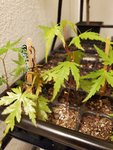Hi All,
Another day, another problem. I love this hobby, but sometimes it can be very demoralizing. I have a very nice shohin japanese maple that very rapidly was struck by what I presume is a bacterial infection.
Day 1: The tree looks healthy. I decide to do some light clean up and remove some minor accessory growth. I pruned back a couple long shoots. Just very minor clean up. The scissors had been sterilized prior to use.
Day 2: Normal day, nothing special to the best of my knowledge.
Day 3: I go out to water my trees and notice that all of the foliage looks wilted. The leaves felt like they had lost all turgor and felt crispy. I assumed that somehow I had missed watering the day before. We have had temps in the 90s with high humidity. I felt stupid but put the tree in shade, watered it and assumed it was going to partially self-defoliate. Here is a picture from that day.
View attachment 258299
Day 4: My whole family gets a horrible GI bug. Enough said.... It rained though.
Day 5: The tree sits in shade. The leaves continue to look worse.
Day 6: I come home from work and have to move the trees around before leaving for a four day vacation. The leaves are looking pretty bad and so I decide to just defoliate them since they were going to fall off anyway. About 15 minutes before I have to get into the car and go, I notice a discoloration on one of the stems (see picture below). There is nothing I could do at the time, except fret about it while on my trip.
View attachment 258300
Day 10: I come back home from my trip and notice additional purple/black discoloration on many stems. It is very patchy, sometimes involving primary, secondary, or tertiary branches. See picture below.
View attachment 258301
I don't have a great zoomed out picture from before I left and I was in such a hurry I can't be sure how much/if this has progressed in the last few days. My assumption was that given the very fast rate of progression this must be a bacterial infection. I found this
article from Michael Hagedorn suggesting it could be verticillium or pseudomonas. I just gave a total plant drench with phyton 27 and moved it to shade away from everything else. I have read that some people advocate pruning away infected areas, but some areas of blackening are where the primary branch meets the trunk. This would essentially require me to cut off almost all the primary branches.
Any help would be extremely appreciated!! I am at wit's end here as this seemed to come very fast out of the blue.


